Chapter 5 : Support Vector Machines
Exercises
Exercise 1
The fundamental idea behind Support Vector Machines is to create a boundary (margin) between classification classes which is defined by the support vectors. The goal is to limit the number of margin violations. In regression, the goal is to have the margin encompass as many samples as possible.
Exercise 2
A support vector defines the “edges” of the street (margin) produced by the SVM. They’re all that matter when creating the SVM.
Exercise 3
It’s important to scale the inputs when using an SVM because if all the inputs all the same scale it will be easier to produce a boundary with a larger margin.
import matplotlib.pyplot as plt
import numpy as np
x = 2*(np.random.random(100) - 0.5)
y = 2*(np.random.random(100) - 0.5)
plt.scatter(x[y<x], y[y<x])
plt.scatter(x[y>x], y[y>x])
x = x*100
plt.figure()
plt.scatter(x[y<x], y[y<x])
plt.scatter(x[y>x], y[y>x])
<matplotlib.collections.PathCollection at 0x113322cd0>
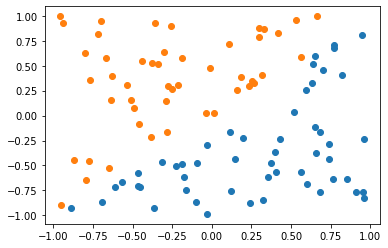
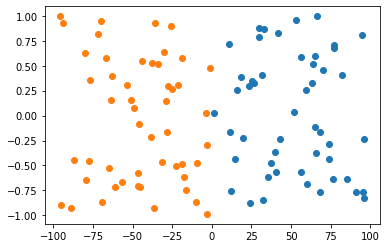
Hopefully, this is visible from above. In the second figure, the y value is insignificant because it is vastly outscaled by x. Clearly, when they are of equal scales both x and y are significant in determining a boundary.
Exercise 4
Yes, LinearSVC can output a confidence score with the decision_function method. This could be turned into probability by scaling to the [0,1] per:
Since SVC does not output probabilities by default, we naively scale the output of the decision_function into [0, 1] by applying min-max scaling.
Exercise 5
I think you’d want to use the primal solution if the number of samples greatly outnumbers the number of the features.
Exercise 6
If you’re underfitting you should increase gamma because it will reduce the influence of individual samples (encouraging a tighter more irregular boundary around each). C is inversely proportional to regularization. So, if you’re underfitting and want less regularization you should increase C, as well.
Exercise 7
See the QP formulation of the SVM problem in 5-5.
Exercise 8
Train a LinearSVC on a linearly separable dataset. Then train an SVC and a SGDClassifier on the same dataset. See if you can get them to produce roughly the same model.
from sklearn.datasets import load_iris
iris = load_iris()
X, y = iris["data"], iris["target"]
plt.scatter(X[y==0][:, [2]], X[y==0][:, [3]])
plt.scatter(X[y==1][:, [2]], X[y==1][:, [3]])
<matplotlib.collections.PathCollection at 0x11fe010d0>
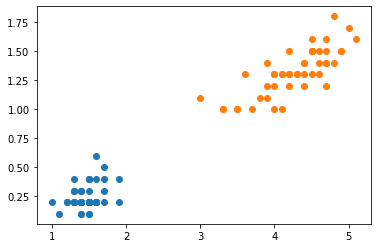
from sklearn.svm import LinearSVC
from sklearn.pipeline import make_pipeline
from sklearn.preprocessing import StandardScaler
X = X[y <= 1][:, [2, 3]]
y = y[y <= 1]
lsvc_clf = make_pipeline(StandardScaler(), LinearSVC())
lsvc_clf.fit(X, y)
print(lsvc_clf.named_steps['linearsvc'].__dict__)
{'dual': True, 'tol': 0.0001, 'C': 1.0, 'multi_class': 'ovr', 'fit_intercept': True, 'intercept_scaling': 1, 'class_weight': None, 'verbose': 0, 'random_state': None, 'max_iter': 1000, 'penalty': 'l2', 'loss': 'squared_hinge', 'n_features_in_': 2, 'classes_': array([0, 1]), 'coef_': array([[0.90014856, 0.83424083]]), 'intercept_': array([0.2607337]), 'n_iter_': 30}
X_scl = StandardScaler().fit_transform(X)
clf = LinearSVC()
clf.fit(X_scl, y)
plt.scatter(X_scl[y == 0][:, 0], X_scl[y == 0][:, 1])
plt.scatter(X_scl[y == 1][:, 0], X_scl[y == 1][:, 1])
a = -clf.coef_[0][0] / clf.coef_[0][1]
b = -clf.intercept_[0] / clf.coef_[0][1]
y_line = a * X_scl + b
plt.plot(X_scl.flatten(), y_line.flatten())
plt.xlim(-3, 3)
plt.ylim(-3, 3)
print(clf.__dict__)
# https://stackoverflow.com/questions/23794277/extract-decision-boundary-with-scikit-learn-linear-svm
{'dual': True, 'tol': 0.0001, 'C': 1.0, 'multi_class': 'ovr', 'fit_intercept': True, 'intercept_scaling': 1, 'class_weight': None, 'verbose': 0, 'random_state': None, 'max_iter': 1000, 'penalty': 'l2', 'loss': 'squared_hinge', 'n_features_in_': 2, 'classes_': array([0, 1]), 'coef_': array([[0.90015964, 0.83424693]]), 'intercept_': array([0.26072637]), 'n_iter_': 32}
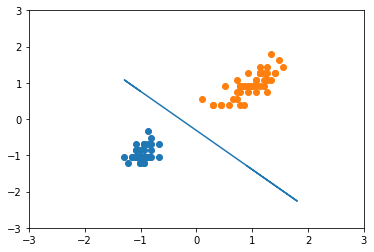
from sklearn.svm import SVC
clf = SVC(kernel="rbf", C=100, gamma=0.1)
# From here: https://github.com/tirthajyoti/Machine-Learning-with-Python/blob/master/Utilities/ML-Python-utils.py
def plot_decision_boundaries(X, y, model, **model_params):
"""
Function to plot the decision boundaries of a classification model.
This uses just the first two columns of the data for fitting
the model as we need to find the predicted value for every point in
scatter plot.
Arguments:
X: Feature data as a NumPy-type array.
y: Label data as a NumPy-type array.
model_class: A Scikit-learn ML estimator class
e.g. GaussianNB (imported from sklearn.naive_bayes) or
LogisticRegression (imported from sklearn.linear_model)
**model_params: Model parameters to be passed on to the ML estimator
Typical code example:
plt.figure()
plt.title("KNN decision boundary with neighbros: 5",fontsize=16)
plot_decision_boundaries(X_train,y_train,KNeighborsClassifier,n_neighbors=5)
plt.show()
"""
try:
X = np.array(X)
y = np.array(y).flatten()
except:
print("Coercing input data to NumPy arrays failed")
# Reduces to the first two columns of data
reduced_data = X[:, :2]
# Instantiate the model object
# model = model_class(**model_params)
# Fits the model with the reduced data
model.fit(reduced_data, y)
print(model.__dict__)
# Step size of the mesh. Decrease to increase the quality of the VQ.
h = .02 # point in the mesh [x_min, m_max]x[y_min, y_max].
# Plot the decision boundary. For that, we will assign a color to each
x_min, x_max = reduced_data[:, 0].min() - 1, reduced_data[:, 0].max() + 1
y_min, y_max = reduced_data[:, 1].min() - 1, reduced_data[:, 1].max() + 1
# Meshgrid creation
xx, yy = np.meshgrid(np.arange(x_min, x_max, h), np.arange(y_min, y_max, h))
# Obtain labels for each point in mesh using the model.
Z = model.predict(np.c_[xx.ravel(), yy.ravel()])
x_min, x_max = X[:, 0].min() - 1, X[:, 0].max() + 1
y_min, y_max = X[:, 1].min() - 1, X[:, 1].max() + 1
xx, yy = np.meshgrid(np.arange(x_min, x_max, 0.1),
np.arange(y_min, y_max, 0.1))
# Predictions to obtain the classification results
Z = model.predict(np.c_[xx.ravel(), yy.ravel()]).reshape(xx.shape)
# Plotting
plt.contourf(xx, yy, Z, alpha=0.4)
plt.scatter(X[:, 0], X[:, 1], c=y, alpha=0.8)
plt.xlabel("Feature-1",fontsize=15)
plt.ylabel("Feature-2",fontsize=15)
plt.xticks(fontsize=14)
plt.yticks(fontsize=14)
plt.xlim(-3, 3)
plt.ylim(-3, 3)
return plt
plot_decision_boundaries(X_scl, y, clf)
{'decision_function_shape': 'ovr', 'break_ties': False, 'kernel': 'rbf', 'degree': 3, 'gamma': 0.1, 'coef0': 0.0, 'tol': 0.001, 'C': 100, 'nu': 0.0, 'epsilon': 0.0, 'shrinking': True, 'probability': False, 'cache_size': 200, 'class_weight': None, 'verbose': False, 'max_iter': -1, 'random_state': None, '_sparse': False, 'n_features_in_': 2, 'class_weight_': array([1., 1.]), 'classes_': array([0, 1]), '_gamma': 0.1, 'support_': array([43, 98], dtype=int32), 'support_vectors_': array([[-0.87430856, -0.3307724 ],
[ 0.09637501, 0.55840072]]), '_n_support': array([1, 1], dtype=int32), 'dual_coef_': array([[-6.28525403, 6.28525403]]), 'intercept_': array([-0.]), '_probA': array([], dtype=float64), '_probB': array([], dtype=float64), 'fit_status_': 0, 'shape_fit_': (100, 2), '_intercept_': array([0.]), '_dual_coef_': array([[ 6.28525403, -6.28525403]])}
<module 'matplotlib.pyplot' from '/Users/riley/PycharmProjects/ML/venv/lib/python3.8/site-packages/matplotlib/pyplot.py'>
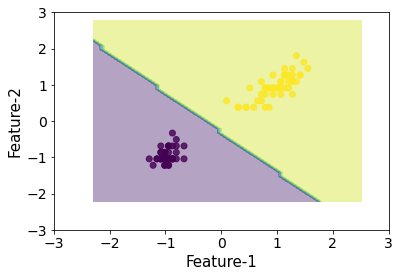
That looks about the same.
from sklearn.linear_model import SGDClassifier
# L1 penalty only
clf = SGDClassifier(l1_ratio=0.2, alpha=0.01)
plot_decision_boundaries(X_scl, y, clf)
{'loss': 'hinge', 'penalty': 'l2', 'learning_rate': 'optimal', 'epsilon': 0.1, 'alpha': 0.01, 'C': 1.0, 'l1_ratio': 0.2, 'fit_intercept': True, 'shuffle': True, 'random_state': None, 'verbose': 0, 'eta0': 0.0, 'power_t': 0.5, 'early_stopping': False, 'validation_fraction': 0.1, 'n_iter_no_change': 5, 'warm_start': False, 'average': False, 'max_iter': 1000, 'tol': 0.001, 'class_weight': None, 'n_jobs': None, 'coef_': array([[1.23946101, 1.06755864]]), 'intercept_': array([0.36044005]), 't_': 701.0, 'n_features_in_': 2, 'classes_': array([0, 1]), '_expanded_class_weight': array([1., 1.]), 'loss_function_': <sklearn.linear_model._sgd_fast.Hinge object at 0x1204576d0>, 'n_iter_': 7}
<module 'matplotlib.pyplot' from '/Users/riley/PycharmProjects/ML/venv/lib/python3.8/site-packages/matplotlib/pyplot.py'>
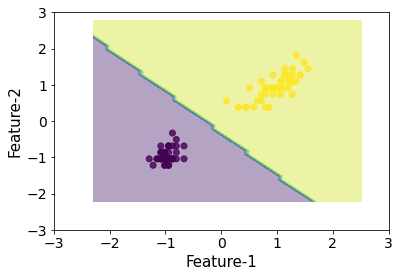
That looks pretty close.
Exercise 9
Train an SVM classifier on the MNIST dataset. Since SVM classifiers are binary classifiers, you will need to use one-versus-all to classify all 10 digits. You may want to tune the hyperparameters using small validation sets to speed up the process. What accuracy can you reach?
# Code from Chapter 3 Exercises
from sklearn.datasets import fetch_openml
import numpy as np
# MNIST changed to https://www.openml.org/d/554
mnist = fetch_openml("mnist_784", version=1, as_frame=False)
# Do this to follow along with Geron
def sort_by_target(mnist):
reorder_train = np.array(
sorted([(target, i) for i, target in enumerate(mnist.target[:60000])])
)[:, 1]
reorder_test = np.array(
sorted([(target, i) for i, target in enumerate(mnist.target[60000:])])
)[:, 1]
mnist.data[:60000] = mnist.data[reorder_train]
mnist.target[:60000] = mnist.target[reorder_train]
mnist.data[60000:] = mnist.data[reorder_test + 60000]
mnist.target[60000:] = mnist.target[reorder_test + 60000]
mnist.target = mnist.target.astype(np.int8)
sort_by_target(mnist)
X, y = mnist["data"], mnist["target"]
print(X.shape, y.shape)
X_train, y_train, X_test, y_test = X[:60000], y[:60000], X[60000:], y[60000:]
# Shuffling
shuf_order = np.random.permutation(len(y_train))
X_train, y_train = X_train[shuf_order, :], y_train[shuf_order]
(70000, 784) (70000,)
# Let's scale (minmax)
X_train_scl, X_test_scl = X_train / 255, X_test / 255
from sklearn.svm import SVC
from sklearn.model_selection import cross_val_score
svc_clf = SVC()
cross_val_score(svc_clf, X_train_scl, (y_train == 0).astype(int), cv=5, scoring="accuracy", verbose=4, n_jobs=4)
[Parallel(n_jobs=4)]: Using backend LokyBackend with 4 concurrent workers.
[Parallel(n_jobs=4)]: Done 2 out of 5 | elapsed: 2.1min remaining: 3.1min
[Parallel(n_jobs=4)]: Done 5 out of 5 | elapsed: 2.8min finished
array([0.99783333, 0.99708333, 0.99758333, 0.99783333, 0.9975 ])
from sklearn.model_selection import RandomizedSearchCV
from scipy.stats import loguniform
params = {"gamma": loguniform(0.0001, 0.1), "C": np.linspace(0.2, 10, 100)}
rs = RandomizedSearchCV(svc_clf, params, verbose=4, cv=3, scoring="accuracy")
rs.fit(X_train_scl[:5000], y_train[:5000])
Fitting 3 folds for each of 10 candidates, totalling 30 fits
[CV 1/3] END C=3.4666666666666672, gamma=0.006660090745344094;, score=0.942 total time= 2.9s
[CV 2/3] END C=3.4666666666666672, gamma=0.006660090745344094;, score=0.948 total time= 2.8s
[CV 3/3] END C=3.4666666666666672, gamma=0.006660090745344094;, score=0.953 total time= 3.0s
[CV 1/3] END C=8.02020202020202, gamma=0.06845249339514203;, score=0.917 total time= 9.9s
[CV 2/3] END C=8.02020202020202, gamma=0.06845249339514203;, score=0.916 total time= 8.6s
[CV 3/3] END C=8.02020202020202, gamma=0.06845249339514203;, score=0.936 total time= 8.5s
[CV 1/3] END C=0.8929292929292931, gamma=0.0002980365384159199;, score=0.842 total time= 7.3s
[CV 2/3] END C=0.8929292929292931, gamma=0.0002980365384159199;, score=0.853 total time= 7.0s
[CV 3/3] END C=0.8929292929292931, gamma=0.0002980365384159199;, score=0.841 total time= 7.1s
[CV 1/3] END C=7.228282828282829, gamma=0.020059214946026357;, score=0.948 total time= 3.9s
[CV 2/3] END C=7.228282828282829, gamma=0.020059214946026357;, score=0.957 total time= 3.9s
[CV 3/3] END C=7.228282828282829, gamma=0.020059214946026357;, score=0.959 total time= 3.9s
[CV 1/3] END C=7.327272727272728, gamma=0.09634966759578674;, score=0.824 total time= 9.0s
[CV 2/3] END C=7.327272727272728, gamma=0.09634966759578674;, score=0.814 total time= 8.9s
[CV 3/3] END C=7.327272727272728, gamma=0.09634966759578674;, score=0.830 total time= 10.1s
[CV 1/3] END C=4.060606060606061, gamma=0.0003646646319049786;, score=0.898 total time= 4.6s
[CV 2/3] END C=4.060606060606061, gamma=0.0003646646319049786;, score=0.906 total time= 4.3s
[CV 3/3] END C=4.060606060606061, gamma=0.0003646646319049786;, score=0.908 total time= 4.3s
[CV 1/3] END C=7.12929292929293, gamma=0.0018645861333376576;, score=0.930 total time= 2.7s
[CV 2/3] END C=7.12929292929293, gamma=0.0018645861333376576;, score=0.936 total time= 3.0s
[CV 3/3] END C=7.12929292929293, gamma=0.0018645861333376576;, score=0.941 total time= 3.0s
[CV 1/3] END C=9.703030303030303, gamma=0.000994723534323507;, score=0.925 total time= 2.6s
[CV 2/3] END C=9.703030303030303, gamma=0.000994723534323507;, score=0.934 total time= 2.9s
[CV 3/3] END C=9.703030303030303, gamma=0.000994723534323507;, score=0.936 total time= 3.7s
[CV 1/3] END C=4.654545454545455, gamma=0.002609206786050118;, score=0.931 total time= 3.4s
[CV 2/3] END C=4.654545454545455, gamma=0.002609206786050118;, score=0.937 total time= 2.8s
[CV 3/3] END C=4.654545454545455, gamma=0.002609206786050118;, score=0.941 total time= 3.1s
[CV 1/3] END C=9.10909090909091, gamma=0.004795054516424456;, score=0.941 total time= 3.3s
[CV 2/3] END C=9.10909090909091, gamma=0.004795054516424456;, score=0.950 total time= 2.7s
[CV 3/3] END C=9.10909090909091, gamma=0.004795054516424456;, score=0.951 total time= 2.6s
RandomizedSearchCV(cv=3, estimator=SVC(),
param_distributions={'C': array([ 0.2 , 0.2989899 , 0.3979798 , 0.4969697 , 0.5959596 ,
0.69494949, 0.79393939, 0.89292929, 0.99191919, 1.09090909,
1.18989899, 1.28888889, 1.38787879, 1.48686869, 1.58585859,
1.68484848, 1.78383838, 1.88282828, 1.98181818, 2.08080808,
2.17979798, 2.27878788, 2.37777778, 2.47676768, 2.57575758,
2.67474747, 2.7...
7.62424242, 7.72323232, 7.82222222, 7.92121212, 8.02020202,
8.11919192, 8.21818182, 8.31717172, 8.41616162, 8.51515152,
8.61414141, 8.71313131, 8.81212121, 8.91111111, 9.01010101,
9.10909091, 9.20808081, 9.30707071, 9.40606061, 9.50505051,
9.6040404 , 9.7030303 , 9.8020202 , 9.9010101 , 10. ]),
'gamma': <scipy.stats._distn_infrastructure.rv_frozen object at 0x1241a7640>},
scoring='accuracy', verbose=4)
best_svc_clf = rs.best_estimator_
best_svc_clf.set_params(**{"verbose": 1})
best_svc_clf.fit(X_train_scl, y_train)
[LibSVM]
SVC(C=7.228282828282829, gamma=0.020059214946026357, verbose=1)
preds = best_svc_clf.predict(X_test_scl)
from sklearn.metrics import accuracy_score
accuracy_score(y_test, preds)
0.9854
Gotta be happy about that :)
Exercise 10
Train an SVM regressor on the California housing dataset.
from sklearn.datasets import fetch_california_housing
housing = fetch_california_housing()
X = housing["data"]
y = housing["target"]
print(X)
housing.feature_names, housing.target_names
[[ 8.3252 41. 6.98412698 ... 2.55555556
37.88 -122.23 ]
[ 8.3014 21. 6.23813708 ... 2.10984183
37.86 -122.22 ]
[ 7.2574 52. 8.28813559 ... 2.80225989
37.85 -122.24 ]
...
[ 1.7 17. 5.20554273 ... 2.3256351
39.43 -121.22 ]
[ 1.8672 18. 5.32951289 ... 2.12320917
39.43 -121.32 ]
[ 2.3886 16. 5.25471698 ... 2.61698113
39.37 -121.24 ]]
(['MedInc',
'HouseAge',
'AveRooms',
'AveBedrms',
'Population',
'AveOccup',
'Latitude',
'Longitude'],
['MedHouseVal'])
# No categorical features so don't have to worry about encoding
from sklearn.model_selection import train_test_split
X_train, X_test, y_train, y_test = train_test_split(X, y, test_size=0.2, random_state=42)
from scipy.stats import describe
print(describe(X_train))
print(describe(y_train))
DescribeResult(nobs=16512, minmax=(array([ 0.4999 , 1. , 0.88888889, 0.33333333,
3. , 0.69230769, 32.55 , -124.35 ]), array([ 1.50001000e+01, 5.20000000e+01, 1.41909091e+02, 2.56363636e+01,
3.56820000e+04, 1.24333333e+03, 4.19500000e+01, -1.14310000e+02])), mean=array([ 3.88075426e+00, 2.86082849e+01, 5.43523502e+00, 1.09668475e+00,
1.42645300e+03, 3.09696119e+00, 3.56431492e+01, -1.19582290e+02]), variance=array([3.62633534e+00, 1.58822990e+02, 5.69955878e+00, 1.87674842e-01,
1.29289721e+06, 1.34067316e+02, 4.56533859e+00, 4.02264613e+00]), skewness=array([ 1.63394113e+00, 6.34476843e-02, 1.86053996e+01, 2.31686410e+01,
5.27565162e+00, 8.80446635e+01, 4.61461577e-01, -2.88391849e-01]), kurtosis=array([ 4.90980008e+00, -8.02296111e-01, 7.69913520e+02, 8.82376143e+02,
8.52238107e+01, 8.61555757e+03, -1.11576039e+00, -1.33672971e+00]))
DescribeResult(nobs=16512, minmax=(0.14999, 5.00001), mean=2.071946937378876, variance=1.33685917467549, skewness=0.9764422910936056, kurtosis=0.31927905894096753)
# Scale, have to use SVR, Grid Search
from sklearn.pipeline import Pipeline
from sklearn.svm import SVR
from sklearn.model_selection import GridSearchCV
svm_reg = SVR(verbose=1)
std = StandardScaler()
X_train_scl = std.fit_transform(X_train)
X_test_scl = std.transform(X_test)
res = cross_val_score(svm_reg, X_train_scl, y_train, cv=10, scoring="neg_mean_squared_error", verbose=4, n_jobs=4)
print(res)
[Parallel(n_jobs=4)]: Using backend LokyBackend with 4 concurrent workers.
[Parallel(n_jobs=4)]: Done 6 out of 10 | elapsed: 24.0s remaining: 16.0s
[-0.31393376 -0.39575933 -0.34247061 -0.33298731 -0.37329516 -0.33903231
-0.32042272 -0.34693177 -0.35551262 -0.37775191]
[Parallel(n_jobs=4)]: Done 10 out of 10 | elapsed: 34.6s finished
print(res)
print(np.sqrt(np.mean(-res)))
[-0.31393376 -0.39575933 -0.34247061 -0.33298731 -0.37329516 -0.33903231
-0.32042272 -0.34693177 -0.35551262 -0.37775191]
0.5914471655449146
params = {"gamma": loguniform(0.0001, 0.1), "C": np.linspace(0.2, 10, 100)}
rs = RandomizedSearchCV(svm_reg, params, verbose=4, cv=3, scoring="neg_mean_squared_error")
rs.fit(X_train_scl, y_train)
Fitting 3 folds for each of 10 candidates, totalling 30 fits
[LibSVM][CV 1/3] END C=9.406060606060606, gamma=0.0008330610897022217;, score=-0.546 total time= 10.1s
[LibSVM][CV 2/3] END C=9.406060606060606, gamma=0.0008330610897022217;, score=-0.500 total time= 10.1s
[LibSVM][CV 3/3] END C=9.406060606060606, gamma=0.0008330610897022217;, score=-0.515 total time= 10.0s
[LibSVM][CV 1/3] END C=9.406060606060606, gamma=0.00034492956720147275;, score=-0.541 total time= 9.8s
[LibSVM][CV 2/3] END C=9.406060606060606, gamma=0.00034492956720147275;, score=-0.515 total time= 9.7s
[LibSVM][CV 3/3] END C=9.406060606060606, gamma=0.00034492956720147275;, score=-0.560 total time= 11.6s
[LibSVM][CV 1/3] END C=4.357575757575758, gamma=0.03210236154205562;, score=-0.383 total time= 11.2s
[LibSVM][CV 2/3] END C=4.357575757575758, gamma=0.03210236154205562;, score=-0.396 total time= 10.2s
[LibSVM][CV 3/3] END C=4.357575757575758, gamma=0.03210236154205562;, score=-0.385 total time= 10.0s
[LibSVM][CV 1/3] END C=9.307070707070707, gamma=0.06300567475327946;, score=-0.349 total time= 11.4s
[LibSVM][CV 2/3] END C=9.307070707070707, gamma=0.06300567475327946;, score=-0.354 total time= 12.2s
[LibSVM][CV 3/3] END C=9.307070707070707, gamma=0.06300567475327946;, score=-0.351 total time= 14.3s
[LibSVM][CV 1/3] END C=7.921212121212123, gamma=0.016265575657955215;, score=-0.398 total time= 11.0s
[LibSVM][CV 2/3] END C=7.921212121212123, gamma=0.016265575657955215;, score=-0.422 total time= 12.2s
[LibSVM][CV 3/3] END C=7.921212121212123, gamma=0.016265575657955215;, score=-0.399 total time= 10.2s
[LibSVM][CV 1/3] END C=8.812121212121212, gamma=0.0024399439215704384;, score=-0.497 total time= 10.6s
[LibSVM][CV 2/3] END C=8.812121212121212, gamma=0.0024399439215704384;, score=-0.471 total time= 10.5s
[LibSVM][CV 3/3] END C=8.812121212121212, gamma=0.0024399439215704384;, score=-0.475 total time= 10.6s
[LibSVM][CV 1/3] END C=0.793939393939394, gamma=0.09870521470417025;, score=-0.370 total time= 9.5s
[LibSVM][CV 2/3] END C=0.793939393939394, gamma=0.09870521470417025;, score=-0.365 total time= 9.8s
[LibSVM][CV 3/3] END C=0.793939393939394, gamma=0.09870521470417025;, score=-0.373 total time= 9.6s
[LibSVM][CV 1/3] END C=3.4666666666666672, gamma=0.0033646683419517446;, score=-0.488 total time= 9.8s
[LibSVM][CV 2/3] END C=3.4666666666666672, gamma=0.0033646683419517446;, score=-0.468 total time= 10.1s
[LibSVM][CV 3/3] END C=3.4666666666666672, gamma=0.0033646683419517446;, score=-0.481 total time= 10.6s
[LibSVM][CV 1/3] END C=8.713131313131314, gamma=0.00816853068696815;, score=-0.419 total time= 10.5s
[LibSVM][CV 2/3] END C=8.713131313131314, gamma=0.00816853068696815;, score=-0.439 total time= 10.6s
[LibSVM][CV 3/3] END C=8.713131313131314, gamma=0.00816853068696815;, score=-0.418 total time= 11.5s
[LibSVM][CV 1/3] END C=3.1696969696969703, gamma=0.09351565434633609;, score=-0.349 total time= 10.7s
[LibSVM][CV 2/3] END C=3.1696969696969703, gamma=0.09351565434633609;, score=-0.347 total time= 10.3s
[LibSVM][CV 3/3] END C=3.1696969696969703, gamma=0.09351565434633609;, score=-0.351 total time= 10.2s
[LibSVM]
RandomizedSearchCV(cv=3, estimator=SVR(verbose=1),
param_distributions={'C': array([ 0.2 , 0.2989899 , 0.3979798 , 0.4969697 , 0.5959596 ,
0.69494949, 0.79393939, 0.89292929, 0.99191919, 1.09090909,
1.18989899, 1.28888889, 1.38787879, 1.48686869, 1.58585859,
1.68484848, 1.78383838, 1.88282828, 1.98181818, 2.08080808,
2.17979798, 2.27878788, 2.37777778, 2.47676768, 2.57575758,
2.674...
7.62424242, 7.72323232, 7.82222222, 7.92121212, 8.02020202,
8.11919192, 8.21818182, 8.31717172, 8.41616162, 8.51515152,
8.61414141, 8.71313131, 8.81212121, 8.91111111, 9.01010101,
9.10909091, 9.20808081, 9.30707071, 9.40606061, 9.50505051,
9.6040404 , 9.7030303 , 9.8020202 , 9.9010101 , 10. ]),
'gamma': <scipy.stats._distn_infrastructure.rv_frozen object at 0x129665a60>},
scoring='neg_mean_squared_error', verbose=4)
from sklearn.metrics import mean_squared_error
preds = rs.best_estimator_.predict(X_train_scl)
mse = mean_squared_error(y_train, preds)
print(np.sqrt(mse))
0.5721795564564917
preds = rs.best_estimator_.predict(X_test_scl)
mse = mean_squared_error(y_test, preds)
print(np.sqrt(mse))
0.5914190290902493
svm_reg = SVR(verbose=1)
svm_reg.fit(X_train_scl, y_train)
preds = svm_reg.predict(X_train_scl)
mse = mean_squared_error(y_train, preds)
print(np.sqrt(mse))
preds = svm_reg.predict(X_test_scl)
mse = mean_squared_error(y_test, preds)
print(np.sqrt(mse))
[LibSVM]0.5797673265358964
0.5974969813107396
So our rs.best_estimator_ was slightly better. Recall here that the targets are in increments of \$10,000 so we have a model whose standard deviation is ~$5,900 off from the median housing price.
